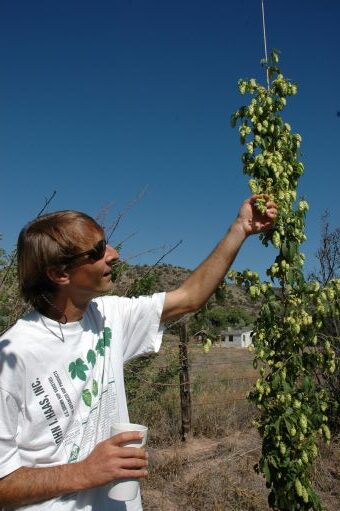From Vol. 6, No. 7, November 2022
CLS Farms has eliminated Medusa, the neomexicanus-only hop that introduced American brewers to a botanical variety of Humulus lupulus that produces unique aromas in beer, from its portfolio. Plants were “grubbed out” after the 2022 harvest.
Before you ask, the future still looks fine for Zappa, a daughter of Medusa, being grown on six farms in five states. “It is time to focus on Zappa and let Medusa go,” CLS co-owner Eric Desmarais wrote via email.
Quite simply, Medusa didn’t measure up agronomically. “(Medusa) doesn’t have the yield to be able to be super viable moving forward in a higher inflationary world, and a much more competitive hop variety landscape,” Desmarais wrote.
“I do think Medusa and Zappa have done a good job of exposing brewers to neomexicanus aromas,” he continued.
A bit of background. The genus Humulus likely originated in Mongolia at least six million years ago. A European type diverged from that Asian group more than one million years ago; a North American group migrated from the Asian continent approximately 500,000 years later. Five botanical varieties of lupulus exist: cordifolius (found in Eastern Asia, Japan), lupuloides (Eastern and north-central North America), lupulus (Europe, Asia, Africa; later introduced to North America), neomexicanus (Western North America), and pubescens (primarily Midwestern United States).
Most hops grown in the United States today are hybrids, usually a cross between Humulus lupulus var. lupulus and Humulus lupulus var. lupuloides, although they may also be a cross between var. lupulus and var. neomexicanus. European landrace varieties such as Saaz and Hallertau Mittelfrüh are var. lupulus.
 Now jump ahead to the 1990s, when Todd Bates (pictured in 2007) moved to New Mexico and began collecting plants growing wild. Bates, who lives on a farm between Santa Fe and Taos, used them in homeopathic tinctures he made, and secondarily for homebrewing. Each group he found had different positive traits, and also certain drawbacks — so he began cross breeding them. He did with neomexicanus alone what other breeders were doing with a combination of botanical varieties.
Now jump ahead to the 1990s, when Todd Bates (pictured in 2007) moved to New Mexico and began collecting plants growing wild. Bates, who lives on a farm between Santa Fe and Taos, used them in homeopathic tinctures he made, and secondarily for homebrewing. Each group he found had different positive traits, and also certain drawbacks — so he began cross breeding them. He did with neomexicanus alone what other breeders were doing with a combination of botanical varieties.
In 2011, Desmarais planted some of Bates’ varieties in the Yakima Valley. “During the growing season, I have consultants walk the fields on a weekly basis, doing disease and pest scouting,” Desmarais said shortly thereafter. “These guys have been walking hop yards for 18 years, and walk most of the US hop industry yards. They see just about everything. I didn’t tell them what these were last year on purpose, to see what their reaction was. They knew they were looking at something very different.”
The hops eventually got the attention of Tom Nielsen, Research & Development and Raw Materials Manager at Sierra Nevada brewing. “The first time I saw them, I thought to myself, ‘I want to do this project. We’re going to do this. It’s going to be done,’” Nielsen told Smithsonian Magazine in 2014. “So we got some samples in and we started brewing with it.”
Sierra Nevada brewed first with Medusa, and Nielsen told the magazine the beer had an unexpected effect on drinkers. “I’m not saying it’s like you’re tripping on acid or anything,” he said, “but you just felt a little different. It was beyond the regular beer buzz.” The brewery continues to use Zappa.
Brewers still interested in brewing with Medusa may buy 2022 crop (or from earlier crop years if the hops have been packaged in nitrogen-flushed mylar bags and stored cold). Stored at sub-freezing temperatures under anaerobic conditions, those hops will retain most of their brewing qualities for several years. (See the link below to a story about using older hops.)
Breeders continue to make crosses using neomexicanus cultivars, valuing them for their potential heat and drought tolerance as well as aroma. Sabro and Lotus are two examples of varieties that resulted from such crosses.